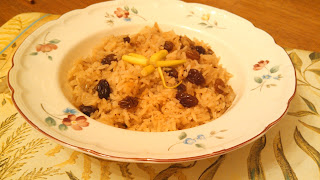I’m , always on the lookout for a good roast chicken recipe, something out of the ordinary. Well, this is one for the ages: Roast Chicken Moroccan Style. I’ve never been to Morocco but, if I do, this is the first dish I’ll order. It’s a heavenly chicken replete with myriad herbs and spices not common to our version of roast chicken. And, as an addition I’ve included a saffron rice recipe that goes great with the chicken. So, impress your family and friends with your worldliness. Give them a roast chicken dish that’s simply marvelous. They’ll sing your praises.
Now, traditionally, with this dish, it is cooked in an outdoor grill. This being winter in the northeast, we cooked the chicken in a preheated broiler and it came out just fine.
ROAST CHIKEN MOROCCAN STYLE
Ingredients:
1 roasting chicken, about 3 to 3¼ pounds, halved or quartered
3 scallions, white parts only, chopped
1 garlic clove, peeled
1 tablespoons fresh chopped parsley
1 tablespoon fresh chopped coriander or 1 teaspoon dried
½ teaspoon salt
1 teaspoon sweet paprika
1 teaspoon ground cumin
¼ teaspoon cayenned pepper
4 tablespoons butter, softened
Instructions:
- Rinse chicken under cold running water and pat dry with paper towels.
- Put the scallions, garlic, herbs, salt and spices in a mortar and pound until crushed. Blend with the butter to make a paste. Rub the paste all over the prepared chicken pieces. Leave the chicken to marinate at room temperature for at least 1 hour.
- Arrange the chicken pieces skin side down under the broiler After 5 minutes turn and baste with any extra paste or the juices in the boiling pan. Continue turning and basting every 5 minutes for approximately 25 minutes or until the pieces are done. Serve with Saffron Rice (recipe given below).
SAFFRON (YELLOW) RICE
ingredients:
2 tablespoons olive oil
1 onion, peeled and chopped
1 clove garlic, peeled and finely chopped
2 cups rice
½ teaspoon saffron threads or ¼ teaspoon saffron powder
Chicken broth, about 3 cups or to cover rice
Salt and black peeper to taste
4 ripe tomatoes, chopped
1 cup finely chopped parsley
Instructions:
- In a large saucepan or pot, heat olive oil and sauté onion and garlic for 5 minutes. Stir in rice and sauté until grains are transparent.
- Add saffron and chicken broth to cover rice by about ¼-inch. Bring to a boil, cover and simmer until rice is tender and liquid absorbed, about 30 to 40 minutes. Add salt and pepper and serve on a platter with tomato and parsley border.
Yield: 4 servings.
















 Sofrito is ubiquitous in Caribbean cooking. One could safely say that Puerto Rican cuisine would be wanting without it. It is an aromatic mix of herbs and spices that is a base for cooking countless criollo dishes. This concept can be found in other cultures as well. One example is the Indian mix called garam masala which is also used as a base flavoring. Or kimchi, the fermented cabbage condiment, so popular in Korean cooking. The word sofrito is a generic term that has no correct English translation. “Frito” in Spanish means fried. Sofrito could be taken to mean stir-fried. Although this would not be entirely accurate. As the recipe shows, sofrito can be whipped up in a few moments’ time in a blender or food processor. And it can be stored in a closed tight jar the refrigerator for three to four days or, in the freezer compartment, indefinitely.
Sofrito is ubiquitous in Caribbean cooking. One could safely say that Puerto Rican cuisine would be wanting without it. It is an aromatic mix of herbs and spices that is a base for cooking countless criollo dishes. This concept can be found in other cultures as well. One example is the Indian mix called garam masala which is also used as a base flavoring. Or kimchi, the fermented cabbage condiment, so popular in Korean cooking. The word sofrito is a generic term that has no correct English translation. “Frito” in Spanish means fried. Sofrito could be taken to mean stir-fried. Although this would not be entirely accurate. As the recipe shows, sofrito can be whipped up in a few moments’ time in a blender or food processor. And it can be stored in a closed tight jar the refrigerator for three to four days or, in the freezer compartment, indefinitely.